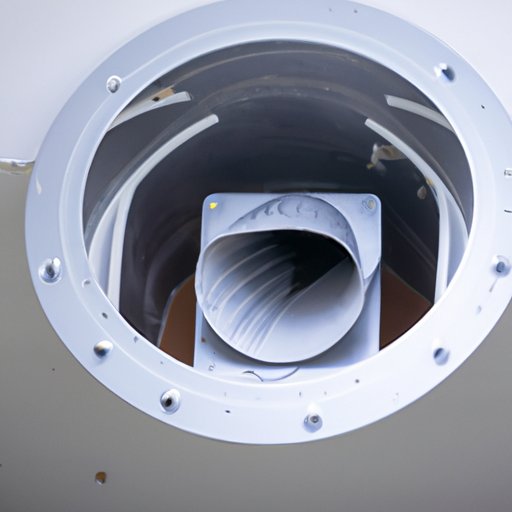Introduction
A dryer vent is an important component of any home. Its function is to transport hot air from the dryer to the outside, preventing lint buildup and promoting safe operation of the appliance. Knowing the location of your dryer vent is essential for maintenance, repairs, and proper installation. In this article, we’ll explore the anatomy of a dryer vent, provide tips for locating it in your home, and discuss considerations for DIY installation.

How to Locate a Dryer Vent in Your Home
The first step in understanding where your dryer vent is located is to check both inside and outside the house. Look around the laundry area for signs of a vent, such as a wall-mounted exhaust fan or a flexible metal tube that runs through the wall. If you can’t find anything inside, look around the exterior of the house for a small opening near the ground. This is likely the exit point for the dryer vent.
If you still can’t find the dryer vent, there are some tricks you can use to help you locate it. Start by turning on the dryer and listening for the sound of air being expelled. If you hear a loud whooshing noise coming from the walls or ceiling, that’s a good indication that you’ve found the vent. You can also inspect the back of the dryer for a connection to a vent hose. If you see one, follow it to the other end to discover where the vent is located.
The Anatomy of a Dryer Vent: What You Need to Know
Before you can understand where a dryer vent is located, it’s important to know the parts and components that make up a dryer vent system. The most common components include a vent hood, duct pipe, transition duct, clamps, and a vent cap. The vent hood attaches to the back of the dryer and directs air out of the house. The duct pipe connects the vent hood to the transition duct, which then connects to the vent cap. Clamps are used to secure the duct pipe and transition duct in place.
Proper installation of a dryer vent is essential for safety and efficiency. The duct pipe should be as short and straight as possible, with few turns and no kinks. The vent cap should be installed at least three feet away from any combustible material and should be checked regularly for blockages and debris. Additionally, the transition duct should be made of flexible aluminum or galvanized steel to ensure that it is weatherproof and won’t collapse over time.
Where is the Dryer Vent Located? A Comprehensive Guide
Now that you know the basics of a dryer vent system, let’s take a look at where they are commonly located. Generally, dryer vents are located on an exterior wall near the back of the house. However, there are a few factors that can affect placement, such as the type of house (single-story or multi-story), the layout of the house, and the availability of an exterior wall.
In some cases, the dryer vent may not be visible from the outside. If this is the case, there are a few signs you can look for to help you uncover its location. Look for a small hole near the ground with a screen covering it, or look for a flexible metal tube running through the walls and floors. If you still can’t find the vent, consult a professional for assistance.

DIY Installation: Where to Place a Dryer Vent
If you’re installing a new dryer vent yourself, there are a few guidelines you should follow for safe placement. Start by measuring the length of the duct pipe and transition duct to determine how far away from the dryer the vent should be. Generally, the vent should be placed at least three feet away from the dryer to ensure proper airflow and prevent lint buildup. Additionally, the vent should be placed at least 12 inches above the ground to avoid water accumulation.
When selecting a location for the vent, consider the type of house you have. For single-story homes, the vent should be placed at least four feet away from any windows or doors. For multi-story homes, the vent should be placed at least three feet away from any windows or doors on the lower level and at least five feet away from any windows or doors on the upper levels.
Conclusion
Dryer vents play an important role in keeping your home safe and energy efficient. Knowing the location of your dryer vent is essential for maintenance, repairs, and proper installation. In this article, we explored the anatomy of a dryer vent, provided tips for locating it in your home, and discussed considerations for DIY installation. Remember to always consult a professional if you’re unsure of the placement of your dryer vent.
By following the steps outlined in this article, you’ll be able to uncover the mystery of the dryer vent location and ensure that your appliance is working safely and efficiently. With the right knowledge and resources, you’ll be able to properly install and maintain your dryer vent for years to come.


